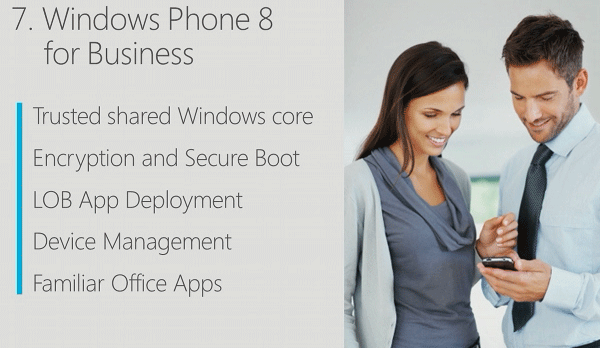As we all knew going back to the Microsoft Build conference the WP8 will fit into Micorost’s plan for a connected home like a puzzle piece. To accomplish this they are leveraging the work they have already put in for Windows RT. WP8 will have the same Windows 8 Kernel that Windows RT will have and will share the same file system (NTFS). The good thing about this is that Microsoft is finally getting rid of the ancient Windows CE kernel that was used in WP7 and 7.5. This means you have expanded support for multi-core ARM based SoCs (but to 64 cores), external storage, NFC, LTE, Improved wireless and more.
Now what kills me about the addition (or we should say re-inclusion) of external storage was that the original Windows Mobile had support for it. I still have an HTC PPC-6700 from Sprint that had the Mini-SD card slot at the top. I was able to not swap it with two other ones that I have here. So at least Microsoft is getting back to where it was in the mobile phone market. WP8 now supports three screen resolutions including the original 800x480 you now get 1280x720 and its extension 1280x768 (so really only two resolutions). We were more than a little surprised that Microsoft did not take the chance to develop in some future support here and go for 1920x1080 though.
As we have told you before Microsoft is hoping that by making the Xbox, Windows 8/RT and Windows Phone all look alike they can build desire for it in the consumer. This rarely happens though as consumers do not really think like that. I know many people that would never think of owning a Mac, but also will not own any other phone than the iPhone, but we are digressing.
Microsoft has also listed some other items to help them catch up to the competition with WP8. You will be getting an e-wallet, on device encryption, and support for IPv6 which will allow the combination of CDMA and LTE (We know Sprint is excited about this).
Developers will also have an easier time with WP8. Because it shares a kernel, file system and basic driver model you can develop for it using standard tools. You do not have to use the compact tool set any longer. You can write in XNA, C# and HTML5 in addition to the native code base.
Existing apps will all be supported and the OS will automatically resize them to fit the native screen resolution. This means that developers do not have to go back and re-write all of the apps just to get them to work properly on the new phone. In all of this the thing that is missing is the consumer focus. Microsoft talks a lot about creating a synergy between the devices in the home and are heading in that direction. The problem is that it might not be one that consumers want to go in.
The tile-based look of the “metro” UI can be garish even if Microsoft has finally allowed the tiles to be resized you only get three choices for size here. Right now I am not sure about Windows Phone 8. Still there is more to Windows Phone 8 than looks and the list here is far from complete. The WP Developer’s Conference runs through tomorrow so we are sure we will see more new features like VoIP bundled in (thanks to Skype) Office 15 coming standard with the phone OS (just like RT), Voice recognition (thanks to Audible), Nokia Map navigation with built-in turn-by-turn navigation.
We do fully expect to see nVidia in this mix as they have been dying to get to the front of someone’s smart phone line for a while (in the US especially). This, at least, is one thing that Microsoft can do to try and get ahead. If they can convince their partners (including Nokia) to drop in a quad-core SoC into a phone aimed at the US and show it not only working, but with compelling software then Windows Phone 8 might stand a chance. As it is, we just do not feel that the features that Microsoft is bringing will sway the market. There are too many other products (iOS and Android) that already have these features and are not encumbered with Metro for the fickle market to suddenly say “wow, I want a Windows Phone”
Discuss this in our Forum

 Microsoft has made Windows Phone 8 semi-official at its Windows Phone Developer Conference happening right now. We call it semi-official because right now Microsoft is not showing off any hardware running it. They are waiting to have that announcement later. So while the OS is out of the bag and we have some new information no one has made any specific announcements of support for the new OS.
Microsoft has made Windows Phone 8 semi-official at its Windows Phone Developer Conference happening right now. We call it semi-official because right now Microsoft is not showing off any hardware running it. They are waiting to have that announcement later. So while the OS is out of the bag and we have some new information no one has made any specific announcements of support for the new OS.

